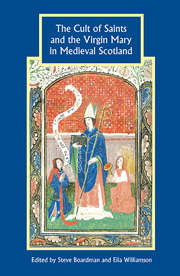Book contents
- Frontmatter
- Contents
- List of Illustrations and Tables
- List of Contributors
- Abbreviations
- Introduction
- 1 The Big Man, the Footsteps, and the Fissile Saint: paradigms and problems in studies of insular saints' cults
- 2 St Munnu in Ireland and Scotland: an exploration of his cult
- 3 The struggle for sanctity: St Waltheof of Melrose, Cistercian in-house cults and canonisation procedure at the turn of the thirteenth century
- 4 Royal and aristocratic attitudes to saints and the Virgin Mary in twelfth- and thirteenth-century Scotland
- 5 A saintly sinner? The ‘martyrdom’ of David, duke of Rothesay
- 6 Wo/men only? Marian devotion in medieval Perth
- 7 Is eagal liom lá na hagra: devotion to the Virgin in the later medieval Gàidhealtachd
- 8 Scottish saints' legends in the Aberdeen Breviary
- 9 Mothers and their sons: Mary and Jesus in Scotland, 1450–1560
- 10 The ‘McRoberts thesis’ and patterns of sanctity in late medieval Scotland
- Index
3 - The struggle for sanctity: St Waltheof of Melrose, Cistercian in-house cults and canonisation procedure at the turn of the thirteenth century
Published online by Cambridge University Press: 05 October 2013
- Frontmatter
- Contents
- List of Illustrations and Tables
- List of Contributors
- Abbreviations
- Introduction
- 1 The Big Man, the Footsteps, and the Fissile Saint: paradigms and problems in studies of insular saints' cults
- 2 St Munnu in Ireland and Scotland: an exploration of his cult
- 3 The struggle for sanctity: St Waltheof of Melrose, Cistercian in-house cults and canonisation procedure at the turn of the thirteenth century
- 4 Royal and aristocratic attitudes to saints and the Virgin Mary in twelfth- and thirteenth-century Scotland
- 5 A saintly sinner? The ‘martyrdom’ of David, duke of Rothesay
- 6 Wo/men only? Marian devotion in medieval Perth
- 7 Is eagal liom lá na hagra: devotion to the Virgin in the later medieval Gàidhealtachd
- 8 Scottish saints' legends in the Aberdeen Breviary
- 9 Mothers and their sons: Mary and Jesus in Scotland, 1450–1560
- 10 The ‘McRoberts thesis’ and patterns of sanctity in late medieval Scotland
- Index
Summary
In mid-1206, a group of six inquisitive lay brothers at the Cistercian house of Melrose made an exciting discovery. The brethren had been preparing a tomb for the recently deceased Abbot William II, who was to be buried alongside the tomb of his saintly predecessor, Abbot Waltheof. Waltheof's most famous attribute was the miraculous preservation of his body, a state that had last been witnessed over thirty years previously in 1171. Overcome by the desire to witness this miracle for themselves, the brothers urged the abbey's mason, Brother Robert, to raise the marble cover of St Waltheof's tomb and peer in.
This second discovery of Waltheof's incorruption was an event that must have both re-awakened interest in the saint's cult and re-opened older questions surrounding its promotion. The immediate response of the house appears to have been to commission the well known Cistercian hagiographer, Jocelin of Furness, to write an official account of Waltheof's life and deeds, a work that was begun during the brief abbacy of William's successor, Abbot Patrick (ob. 1207). The Vita's main intention was to raise the profile of Waltheof's cult. The possession of an incorrupt corpse was, as the Vita makes clear, no common claim. Waltheof joined a select group of only six English saints, the shrines of whom were major sites of pilgrimage in the religious landscape of Britain: Canterbury, Bury St Edmunds, Durham, Ely, and London.
- Type
- Chapter
- Information
- Publisher: Boydell & BrewerPrint publication year: 2010

